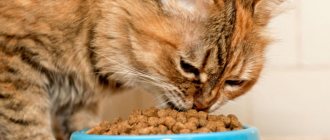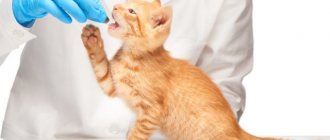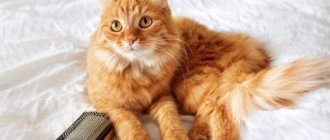Description when assigned
Amoxicillin for cats is effective in treating:
- leptospirosis and salmonellosis;
- enteritis and enterocolitis;
- endometritis and colibacillosis;
- abscess and cystitis;
- diarrhea and intestinal infections;
- mastitis and vaginitis;
- pneumonia.
The medicine is used for inflammation of soft tissues that were caused by infections. Veterinarians often use it to prevent complications that arise after various operations.
Indications for use
First, your furry pet must be shown to a doctor, who will assess the degree of development of the pathology and prescribe treatment with Amoxicillin or another suitable drug and select the correct dosage. The necessary information about the rules for taking the medicine is contained in the instructions for using Amoxicillin in cats, which the owner must familiarize himself with.
For what ailments in cats is it recommended to use Amoxicillin?:
- diseases of the stomach and intestines: enteritis, diarrhea, salmonellosis;
- rhinitis, pneumonia, bronchitis, when the respiratory organs suffer;
- disorders of the genitourinary system: urethritis, cystitis, vaginitis;
- lesions of soft tissues, skin, hooves: abscess, arthritis;
- mastitis, purulent inflammation;
- for the prevention of bacterial infections after sterilization operations or caesarean section.
© shutterstock
Interactions with other drugs and side effects
It is strictly forbidden to combine a medicine such as Amoxicillin for cats with antibiotics, Thiamphenicol, Chloramphenicol.
Before using the drug, you must visit a veterinarian to check that the animal is not allergic to the active substance, and there is no intolerance to the components of its composition. If, after using the medication, your pet develops swelling on the skin or begins to sneeze frequently, you should stop taking it immediately. In addition, it should never be given if you have kidney failure. Before using the medicinal composition, you must read the instructions. Never use it for an extended period of time without consulting your veterinarian.
The suspension is administered only intramuscularly and not into a vein.
Methods of administration
Not all owners can give injections to cats. It is clear that the animal will hiss, struggle, feeling pain from the needle prick, and may scratch the owner. A veterinarian can help with this, but not everyone has the opportunity to get an extra appointment with him. You can learn how to give injections to your pet at home. The procedure is not complicated: pull back the cat’s withers, carefully pierce it with a needle, and then inject Amoxicillin subcutaneously.
If necessary, the injection is repeated approximately every other day, after 48 hours.
You can choose any of the medication options:
- tablet,
- powder,
- suspension.
Most cat owners prefer the latter release form. Amoxicillin for cats in tablets or powders is usually added to the food. A cat, especially a sick one, may not eat its portion and thus take a smaller dose of medicine than necessary. The suspension is drawn in the required quantity into a syringe and administered to the patient. Before use, the bottle of Amoxicillin should be shaken so that the contents become homogeneous. The place where you plan to inject the drug must first be lightly massaged.
The dosage of the drug for a cat is set at the rate of 1 ml of active substance per 10 kg of body weight, or 15 mg per 1 kg of weight. Amoxicillin is administered once, subcutaneously or intramuscularly. In this case, the volume of the medicine should not be more than 20 ml. So, a cat weighing 3 kg will need 0.3 ml of the drug for one dose.
A 15% suspension of Amoxicillin is bottled in bottles with a capacity of 10, 100 and 250 ml. If the disease is severe, your pet may need 2 or 3 injections, so you will need to purchase a larger bottle. For one-time use, a 10 ml bottle will be enough for a small kitten or cat.
The owner must act confidently, quickly and accurately. His excitement can be transferred to the pet, then the procedure will be difficult.
© shutterstock
If you use Amoxicillin in tablets, then according to the instructions, the dose should be 12.5 mg per 1 kg of cat weight. The exact dosage is determined based on the results of an examination by a veterinary clinic doctor.
What can be replaced if necessary?
We list drugs similar to Amoxicillin:
- Amoxil tablets are characterized by good digestibility (the active substances are absorbed into the blood within three hours after administration);
- Amoxisan suspensions are most often used to treat infectious diseases;
- Bactoclav has a wide range of applications.
Amoxisan
Side effects
As a rule, the animal may develop swelling at the injection site, which goes away on its own within a few days.
To prevent its occurrence, it is recommended after the injection to massage the injection site with light and smooth movements.
If an animal develops an allergic reaction to a drug, it is necessary to immediately stop treatment and be sure to consult a veterinarian to change the medication. To eliminate allergy symptoms, the cat is prescribed glucocorticosteroids, as well as enterosorbents. Treatment is carried out symptomatically.
In rare cases, the use of the drug may cause the following side effects:
- diarrhea;
- vomit;
- disruptions in the functioning of the heart, in particular tachycardia;
- violation of spatial perception and others.
As a rule, such side effects occur after an overdose of the drug, when the animal was given a tablet. To eliminate them, it is necessary to discontinue the medication and prescribe symptomatic treatment.
Very often, while taking an antibiotic, a cat can develop dysbacteriosis, as well as weaken its immunity. Therefore, in parallel with treatment with Amoxicillin, various vitamin complexes, immunostimulants, and probiotics containing bifidobacteria and lactobacilli are prescribed, which help restore the normal microbiota of the gastrointestinal tract.
reviews
Vaska had terrible diarrhea for several days. After 3 days of his torment, I took the animal to the veterinarian. The result was dysentery. The doctor recommended Amoxicillin. I gave the powder for four days. Over time, the cat began to eat normally and gradually recovered. He tolerated the medicine quite well. No additional medications were needed.
After the kittens were born, we decided to wean them off the cat's breast early. As a result, mastitis developed. They thought that everything would go away on its own, but it was obvious how much pain she was in, so they brought her to the vet. To prevent complications, the veterinarian injected her with Amoxicillin for cats. Two days later, the administration of the drug was repeated. Three days later, the cat became healthy and cheerful, began to eat normally, and the mastitis disappeared. Thanks doctor!
How to give a cat a suspension video
Contraindications and side effects
The drug should not be used for dogs that are hypersensitive to penicillin antibiotics.
If medications of this group have not previously been used for the animal, upon first administration it is necessary to observe the body’s reaction. The antibacterial agent has no other contraindications and can be used for dogs of different breeds and weights. Consultation with a doctor is required if the animal has severe kidney disease. Amoxicillin is usually well tolerated by animals and has no side effects. In case of hypersensitivity to the medicine, an allergic reaction may develop. In this case, further use of Amoxicillin is excluded, and the animal is prescribed symptomatic treatment. Drugs are selected individually depending on the characteristics of the allergy.
In rare cases, slight swelling may appear at the injection site. There is no need to treat it specifically; redness and swelling go away on their own within 1-2 days. To prevent swelling, it is recommended to lightly massage the injection site after administering the suspension. This will help distribute the fluid evenly in the soft tissues.
Note! It is strictly forbidden to mix Amoxicillin with any other medications. Do not use the drug simultaneously with other antibacterial agents, as well as chemotherapy drugs.
The drug should not be used simultaneously with other antibacterial agents, as well as chemotherapy drugs.
Composition and action
The basis of the drug is amoxicillin trihydrate. This is an active substance of the penicillin series, which is effective against many pathogenic microorganisms, including Salmonella, Clostridia, Escherichia, Staphylococcus, Streptococcus, Listeria, Enterococcus, Leptospira and others. Some pathogenic bacteria can cause diseases that are dangerous for cats, so veterinarians prescribe antibiotics for bacterial infections.
Once in the body, the antibiotic begins to act quickly: amoxicillin destroys the cell membranes of bacteria, blocking the production of enzymes necessary for their life.
Injections begin to act faster than tablets, so the veterinary drug is produced in the form of a ready-made solution for injections. Intramuscular and subcutaneous injections for cats are painless, and the drug is quickly absorbed into the blood, providing a therapeutic effect for 12 hours. The active substance reaches its maximum concentration in the blood plasma within one to two hours.
Important!
Antibiotics kill not only harmful, but also beneficial microflora. To restore the balance of beneficial and harmful bacteria after antibiotic therapy, veterinarians prescribe a course of probiotics.
Amoxicillin injections: instructions for use for cats
The medicine is used, among other things, to treat cats and cats, the following diseases:
- Gastrointestinal tract (examples: diarrhea, colibacillosis, enteritis, salmonellosis);
- respiratory system (pneumonia, rhinitis, bronchopneumonia);
- genitourinary system (endometritis, cystitis, vaginitis, metritis, etc.);
- for lesions of the skin and soft tissues in order to prevent infections that occur after operations if microorganisms are sensitive to amoxicillin;
- mastitis
The drug is available in three forms:
- In tablets, the weight of which is 0.25 and 0.5 grams, and they can be packaged both in plastic jars (there are 24 tablets) and in plates (10 pieces each),
- As a liquid for injection, it has a white or white-yellow color. It is administered intramuscularly.
- In powder form. It must be mixed with water or food.
In what doses should I give the drug in tablets to a cat? Owners and some veterinarians do not like this form of release. Because it should be 12.5 mg per kg of animal weight. And calculating the dose is often difficult.
In some cases, there is a different dosage if the veterinarian considered it necessary to indicate this.
If we talk about such a form of release as injections, then the drug is available in bottles of 100 and 10 ml. Which is very convenient if your pet does not have a severe form of his disease, and he is prescribed only 1 to 3 injections.
Before giving your cat an injection, be sure to shake the bottle. It is also important to make sure that both the needle and syringe are completely dry. It is advisable for the cat to give a light massage to the future site of drug administration.
The drug can be bought in tightly closed glass vials of different volumes; it can be said to vary diametrically, from 10 to 250 milliliters.
The active substance contained in one milliliter of this liquid also differs, although not so much, 150 or 200 mg.
Typically, veterinarians use injections (15 percent solution). Of course, veterinary pharmacies sell suspensions for injections, but some experts do not recommend using it, because in their opinion, tumors may appear at the injection site, and also, in their opinion, because the procedure is unnecessarily painful.
And again it all depends on the form of release. If we talk about tablets, veterinarians usually prescribe them for 5-7 days. You need to calculate 12.5 mg for every kilogram of the cat’s weight.
For example, if an animal weighs 2.5 kg or more, then it should be given a quarter of a tablet. From 3 to 5 kg – half. With a weight from 5 to 7.5 - ¾, from 8-10 kg - a whole one.
The tablet should be given before or after meals. It is better to give to animals, including kitties, in the form of syrup (about 20 ml of water) or in the form of a suspension.
If we talk about liquid for injection, then the medicine is administered intramuscularly or under the skin of the animal.
Calculate 1 ml per 10 kg of cat weight. The bottle must be shaken first to obtain a homogeneous mass, i.e. a suspension, one might say. Before administration, a light massage is performed on the area where the drug will be injected.
This again depends on what form the medicine is taken in.
If the injections are for intramuscular administration, then the likelihood that the cat will receive an “overdose” of the medicine is extremely small.
By the way, after administering the injection, you need to lightly massage the injection site. That is, both before and after administration. If in powder, then, in principle, too. The dose is easy to calculate.
But if you use it in tablets, an overdose is very likely. Because it is extremely difficult to calculate the weight of the tablet and correlate it with the weight of the animal.
It should be recalled that the proportion of antibiotic in tablet form is 12.5 milligrams per 1 kilogram of kitty weight. And if the weight of the animal is small, for example, we are talking about a kitten, choosing the correct dosage of the medicine is very difficult, so it is better for the owner to use solutions or injections.
There is no need to self-medicate your cat; it is even strictly prohibited, since any antibiotic, including the one in question, has its own side effects. The most common manifestation is allergies. The place where the injection was administered may well become swollen, red, and conjunctivitis may begin to develop.
If the situation is more severe, allergies may develop. If there is a hint of these reactions, the drug should be discontinued without delay.
Side effects include vomiting (possible), very severe diarrhea, and the cat’s taste preferences may change dramatically.
Rarely, but still there have been cases of even ulcerative stomatitis due to the fact that the cat took this medicine. The animal's behavior may also change. He may have a slow reaction or overly excited behavior.
Taking the drug in form can lead to sensations of pain at the site of drug administration, and the cat begins to walk with a limp. Difficulty breathing and hoarseness can be observed in a number of animals. Long-term and unnecessary use (i.e., without the knowledge of the veterinarian) of an antibiotic can give rise to the development of fungi in the mouth and even diseases of the genital organs.
The modern range of medicinal veterinary drugs for cats is represented by a variety of drugs that allow you to quickly and safely solve pet health problems. Despite the fact that felines are strong, resilient and even capable of self-healing animals, they can suffer from a number of ailments that can only be treated with medication.
Veterinarians often prescribe amoxicillin for cats. This is a medicine from the class of antibiotics, one of the cheapest and most effective. Amoxicillin for cats has a broad spectrum of action and is effective against pathogenic microorganisms. Below we will talk in more detail about the action of the substance, diagnoses, when it is prescribed, and also provide general information about the regimens for using this antibiotic.
The antibiotic amoxicillin is a beta-lactam drug and has a wide spectrum of action aimed at pathogenic microorganisms of gram-negative and gram-positive strains. Once in the animal’s body, amoxicillin penetrates the cell membranes of bacterial cells and disrupts the synthesis of mucopeptides in them.
As a result, the permeability of this membrane increases, and due to impaired osmotic pressure, the bacterium dies and is then excreted from the body. By the way, within twelve hours, 90% of the antibiotic is excreted in the urine and liver secretions, while amoxicillin remains unchanged, without being metabolized in the cat’s body and without being destroyed.
We invite you to familiarize yourself with Pyoderma in cats and cats - symptoms, treatment, medications, causes of occurrence
The antibiotic has several forms of release: ampoules with solution or suspension for injection, tablets. Depending on the doctor’s prescription, the appropriate form factor of the drug is selected, the most effective in a particular situation. Despite the fact that injections are considered the most gentle for the cat’s body and the therapeutic effect from them is achieved faster, not every animal allows itself to be given injections.
Amoxicillin comes in different forms
If in a veterinary clinic doctors are able to give a cat an intramuscular injection, then for home treatment the tablet form of amoxicillin is often chosen. Giving a pill to an animal is much easier; it does not require any special skill.
The drug has more than a dozen analogues, but they are rarely used in veterinary medicine. One can highlight, perhaps, Amoxiclav, which contains amoxicillin mixed with clavulanic acid. This “cocktail” lasts longer in the cat’s body in a medicinal concentration and is considered more powerful than pure amoxicillin.
It is easier for any cat to give a pill than to give an injection
We mentioned above that Amoxicillin is sold in three forms: tablets, suspension and injection solution. The last two are most preferable from a therapeutic point of view, since they do not affect the stomach and intestines of the animal, are absorbed faster and remain effective longer. In addition, the animal may vomit the tablet when the owner does not see it, and the therapeutic effect will be lost. This cannot happen with an injection.
Amoxicillin solution and suspension are administered intramuscularly or subcutaneously; usually the injection is given once, approximately once every two days. The drug is calculated based on the weight of the animal: 15 milligrams of the drug are set per kilogram of weight (15 mg/1 kg).
When using Amoxicillin in tablet form, you need to proceed from the following calculation: 12.5 milligrams per kilogram of cat weight (12.5 mg/1 kg). If necessary, the tablet should be divided into parts.
You should try not to worry - pets are very sensitive to the mood and condition of their owner!
The injection must be given as decisively as possible. At the same time, the movements must be precise and very careful.
According to the instructions for use, Amoxicillin is prescribed to cats in the following cases:
- with leptospirosis;
- for salmonellosis;
- with enteritis;
- with enterocolitis;
- with an abscess;
- with cystitis;
- with endometritis;
- with mastitis;
- with vaginitis;
- with colibacillosis;
- with diarrhea;
- for rhinitis;
- with pneumonia;
- for intestinal infections;
- for other pathologies caused by penicillin-sensitive bacteria.
The drug can also be used for inflammatory processes of soft tissues caused by infections. The drug is also used to prevent complications after surgery.
Note! The drug, like other antibiotics, can be used to treat cats only as prescribed by a doctor. You should not use Amoxicillin for self-medication, since if the dosage and use are incorrect, it can cause deterioration in your health.
A contraindication for the use of antibacterial agents for cats is individual intolerance to penicillins. You should also stop using antibiotics in the following cases:
- in case of renal failure and serious impairment of kidney function;
- with liver failure.
Reviews from veterinarians
Sometimes Amoxicillin (for cats) may be contraindicated. In which cases? If the kitty has hypersensitivity to the main active substance or, in general, to any other penicillin antibiotics.
It is extremely undesirable to use the drug during lactation, since it is also excreted through milk. The only exception is if the owners seek to cure mastitis in their cat while feeding the kittens.
The advantages of Amoxicillin are its effective fight against pathogenic bacteria, cumulative effect, safe, gentle action, and low cost.
Disadvantages - possible side effects, prescription.
Features of application
Amoxisan should not be given to cats if the body is hypersensitive to amoxicillin. Injections are prescribed to pregnant and lactating cats with caution: the negative effect of the antibiotic on offspring has not been fully studied. Therefore, kittens are transferred to artificial feeding during treatment.
The medicine can be prescribed to kittens, but they do not tolerate the pain of injections well, so Amoxisan analogues are more often used in the form of tablets or oral solution.
If the dosage is observed, taking the antibiotic occurs without negative side effects; in rare cases, allergies are possible.
Owner reviews
Tatyana, owner of a 3-year-old cat:
“We used Amoxicillin on our cat twice. The first time we were prescribed it for the treatment of cystitis, the second time after sterilization to prevent complications. Both times, Marquise tolerated the injections well. They gave injections subcutaneously (themselves). Inexpensive, but a good drug."
Marina, owner of a British cat:
“I didn’t even suspect that cats could get pneumonia. When our Briton developed a cough, at first they didn’t pay much attention, but when breathing became difficult, they went to the hospital. The doctor prescribed a comprehensive treatment, but the main function was assigned to the antibiotic Amoxicillin. 2 hours after the first injection, the cat began to breathe more smoothly and easily, and became more active (before that he lay almost motionless). It took 2 more injections for him to fully recover. Now nothing even reminds me of the unpleasant event.”
Dosage forms
The antibiotic amoxicillin is produced in three dosage forms:
- pills,
- powder that must be mixed with food or water,
- in liquid form - solution for injection.
Most pet owners note the greatest convenience in using the latter option. Difficulties in determining the dosage arise when choosing a method with tablets. While powder mixed with food does not guarantee that the cat will receive the required amount of the drug.
However, the option with tablets is suitable for those owners who are hesitant to give their cat an injection, or are afraid to do it incorrectly.
Pill or injection?
The least painful way to inject a cat is to inject it into the withers. Although it will not be possible to completely eliminate the unpleasant sensations, the drug is quite painful. It is best to neutralize the cat by wrapping it in a blanket and leaving a clear area for the injection. Before directly piercing the skin, it is necessary to rub the skin.
The drug is available in the following forms:
- Tablets 0.25 and 0.5 g in contour plates of 10 pcs. or glass jars;
- Suspension (white or yellowish oily substance) for intramuscular administration in glass bottles of various volumes;
- Powder for mixing with water or food, with packaging from 50 g and above.
| Pills | Suspension | Powder | |
| Active substance concentration | 250 mg per piece. | 15% | 15% |
| Auxiliary components | Lactose, colloidal silicon dioxide, magnesium stearate | Water | No |
Method of using Amoxicillin tablets
If for some reason you cannot treat your pet with the described drug, the veterinarian can recommend analogues such as Amoxin, Xiclav, Amoxiclav, and so on.
Tablets differ from suspensions in the presence of clavulanic acid in their composition, which enhances the effective effect of the product.
This form of release is especially convenient in the treatment of small kittens and aggressive animals.
As for tablets such as Amoxicillin, the dose for a cat should be carefully calculated by the veterinarian according to the attached instructions. This is done taking into account the weight of the animal: 12.5 mg of the product per kilogram of weight. For example, if a cat weighs 2.5 kg, she will need only 1/4 of a tablet, if 3-5 kg - 1/2, if 5-7.5 kg - 3/4, if 8-10 kg - a whole pill.
You can give medicine to your animal both during and after meals.










